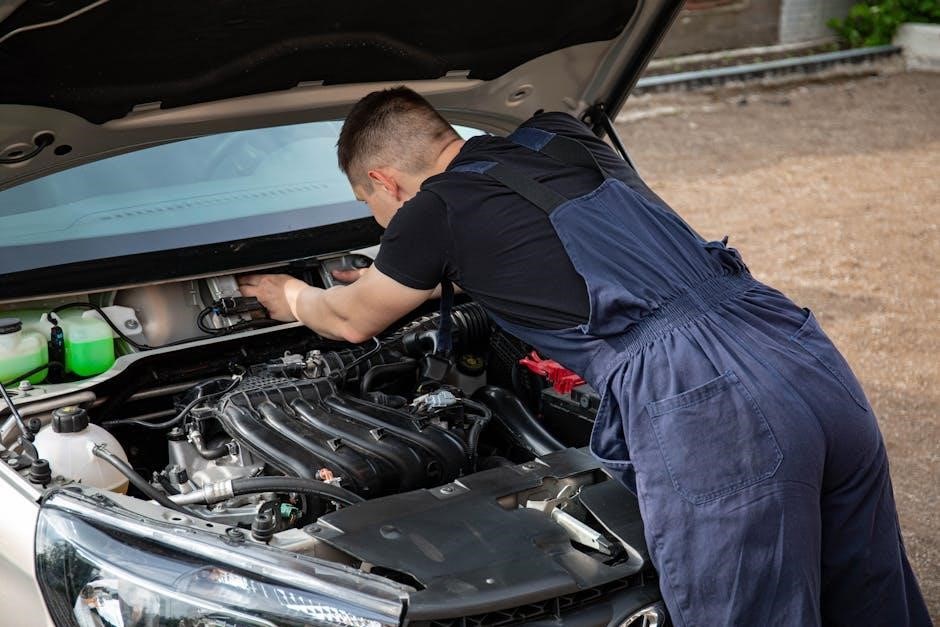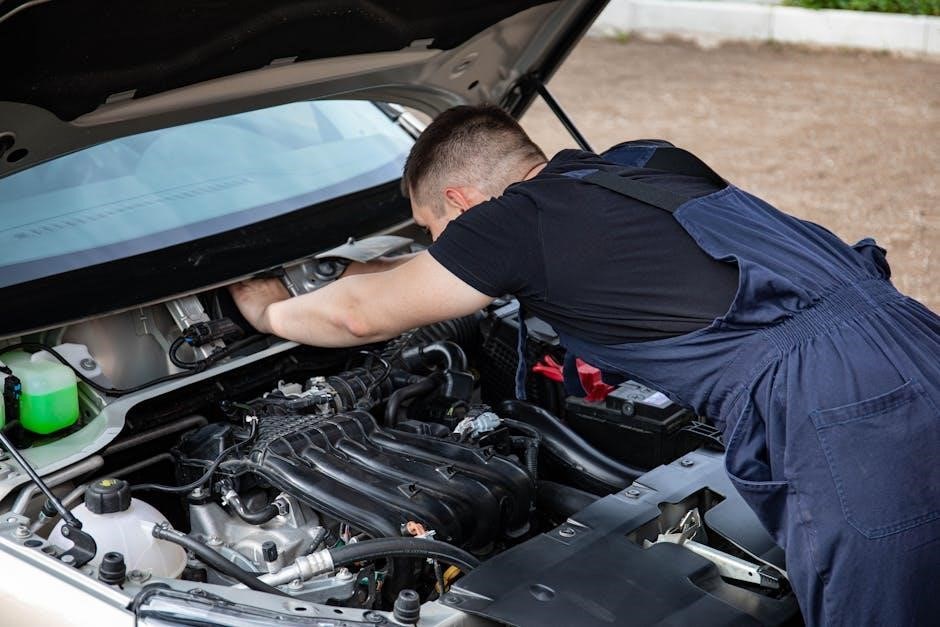Troubleshooting the Nintendo Wii involves addressing common issues like remote syncing, disc errors, and connectivity problems. Simple steps often resolve these, improving performance and extending system lifespan. Proper maintenance and understanding error codes can prevent future issues, ensuring smooth gaming experiences.
1.1 Overview of Common Wii Issues
The Nintendo Wii often encounters issues such as remote syncing problems, disc read errors, and power-related failures. Connectivity issues, like Wi-Fi disconnections, are also frequent. Many of these problems can be resolved with simple troubleshooting steps, such as resetting the console or syncing accessories properly. Regular maintenance, like cleaning the disc drive and updating firmware, can prevent issues. Understanding these common problems helps users address them effectively, ensuring uninterrupted gaming experiences and extending the console’s lifespan.
1.2 Importance of Proper Troubleshooting
Proper troubleshooting is essential for maintaining the Wii’s performance and longevity. Ignoring issues can lead to permanent damage, such as corrupted data or hardware malfunctions. Regular checks and timely fixes prevent minor problems from escalating. Effective troubleshooting also enhances gaming experiences by ensuring smooth operation and connectivity. By addressing issues systematically, users can save time and avoid costly repairs, keeping their Wii in optimal condition for years of enjoyable gaming.

Hardware-Related Issues
Hardware issues with the Wii often involve the Bluetooth board, disc drive, and AC adapter. Problems like syncing failures, disc errors, and power malfunctions can disrupt gameplay and system functionality.
2.1 Wii Remote Not Working or Syncing Correctly
If the Wii Remote fails to sync or respond, ensure it’s properly paired with the console. Check for interference from other devices and verify battery levels. Resetting the remote by pressing the SYNC button on both the remote and console can resolve connectivity issues. If problems persist, try recalibrating the remote or replacing the batteries. Regular maintenance and proper handling can prevent such issues, ensuring smooth gameplay and consistent performance. Always refer to the official Nintendo troubleshooting guide for detailed instructions.
2.2 Wii Disc Drive Problems (Ejecting Issues)
When the Wii disc drive fails to eject, press and hold the eject button for 5-10 seconds. If this doesn’t work, unplug the power cord, wait a minute, and retry. Sometimes, tilting the console with the disc drive facing down can dislodge stuck discs. Ensure no obstructions are blocking the eject mechanism and only use authorized Wii discs to prevent such issues.
2.3 Wii Console Power Issues
Power issues with the Wii can often be resolved by resetting the AC adapter. Unplug it from both the console and the power outlet, wait for at least 30 seconds, and then reconnect it. If the console doesn’t turn on, check the power cord for damage or try using a different outlet. In some cases, removing the clock battery and resetting the system may also resolve power-related problems. Always ensure the console is placed in a well-ventilated area to avoid overheating, which can cause power failures.

Software and Firmware Problems
Software and firmware issues on the Wii can cause errors and system instability. Regular updates and proper installation of firmware help maintain performance and security, ensuring smooth gameplay.
3.1 Error Codes and Their Meanings
Wii error codes indicate specific issues, such as system failures or connectivity problems. For example, the FORE000006 error relates to an incorrect system clock, requiring a reset. Other codes may signal disc read errors or network issues. Understanding these codes helps in applying the correct fixes, like restarting the console, resetting the AC adapter, or checking connections. Referencing official Nintendo guides or support pages provides detailed solutions for each error, ensuring effective troubleshooting.
3.2 Firmware Update Failures
Firmware update failures can occur due to interrupted downloads or unstable internet connections. If an update fails, the Wii may display error codes or freeze. To resolve this, restart the console, ensure a stable connection, and retry the update. If issues persist, resetting the AC adapter or removing the clock battery may help. Always use official Nintendo sources for updates and follow their troubleshooting guides to avoid system instability or corruption during the process.
3.4 Resetting the Wii System
Resetting the Wii system can resolve software issues without affecting saved data. To reset, go to the Wii Settings, select “System Settings,” and choose “System Reset.” Enter the PIN if prompted and confirm. This restores default settings. For a manual reset, unplug the power cord, wait one minute, then replug it. This clears temporary glitches. If issues persist, removing the clock battery or resetting the AC adapter may be necessary. Always back up data before performing a system reset to avoid potential loss of game saves or downloaded content.

Connectivity and Wi-Fi Issues
Connectivity issues often arise from incorrect Wi-Fi settings or router interference. Restarting the Wii and router can resolve connection problems. Ensure proper synchronization of accessories like the Wii Remote for optimal performance. Slow downloads may indicate poor network strength or high traffic. Check signal stability and update firmware regularly to maintain smooth online functionality and prevent disconnections during gameplay or downloads.
4.1 Troubleshooting Wi-Fi Connectivity
Troubleshooting Wi-Fi connectivity on the Wii involves checking internet settings and router connections. Ensure the Wii is configured correctly with the right SSID and password. Restart both the console and router to refresh the connection. If issues persist, verify signal strength and reduce physical obstructions. Update the Wii’s firmware to the latest version for improved compatibility. Additionally, check for interference from other devices operating on the same frequency band. Visit Nintendo’s support site for detailed step-by-step guides and common solutions to restore connectivity effectively.
4.2 Slow Downloads and Connection Errors
Slow downloads and connection errors on the Wii can be resolved by optimizing network settings and improving stability. Restart the Wii and router to refresh the connection. Use a wired Ethernet connection for faster speeds. Ensure the Wii is updated with the latest firmware. Check for nearby devices causing interference and adjust the router’s channel. Verify the integrity of the router’s firmware and update if necessary. These steps help stabilize the connection and improve download speeds for a smoother gaming experience online.
4.3 Synchronizing the Wii Remote with the Console
Synchronizing the Wii Remote with the console ensures proper communication for gameplay. Press the SYNC button on the Wii Remote and the console simultaneously to establish a connection. If issues persist, reset the AC adapter by unplugging it, waiting a few minutes, and reconnecting. Also, press and hold the B button on the remote while syncing to reset its connection. Ensure no devices are causing interference and restart both devices if syncing fails repeatedly for optimal performance.

Disc and Game-Related Problems
Common disc issues include games not loading or freezing, often due to dirt, scratches, or improper insertion. Clean the disc lens and ensure correct alignment for optimal performance.
5.1 Disc Not Reading or Loading
If your Wii disc isn’t reading or loading, ensure it’s clean and free from scratches. Inspect the disc for damage and clean it with a soft cloth. Check the disc drive for dust or debris. Properly align the disc label to the right when inserted. Restart the console after cleaning or replacing the disc. If issues persist, try updating the Wii’s firmware or resetting the system. Ensure the disc is compatible with your Wii model for optimal performance.
5.2 Game Freeze or Crashing Issues
Game freezing or crashing on the Wii can occur due to overheating, corrupted save data, or outdated firmware. Ensure the console is in a well-ventilated area to prevent overheating. Check for firmware updates and install the latest version. If a specific game frequently crashes, try deleting and redownloading its data or restarting the console. Corrupted save files may also cause issues, so verify their integrity or restore from a backup if necessary.
5.3 Scratched or Damaged Discs
Scratched or damaged discs can prevent games from loading or cause gameplay interruptions. Gently clean the disc with a soft cloth to remove dirt or smudges. If the issue persists, consider using a disc repair service or replacing the damaged disc. Always store discs in protective cases to avoid scratches. Ensure the Wii’s disc drive is clean and free from dust, as this can exacerbate damage. Proper care and handling of game discs will help maintain optimal performance and longevity.
Controller and Accessory Issues
Common issues with Wii controllers and accessories include syncing problems, unresponsive buttons, and connectivity errors. Basic troubleshooting steps often resolve these problems, ensuring smooth gameplay.
6.1 Nunchuk and Wii Remote Plus Problems
The Nunchuk and Wii Remote Plus can experience issues like synchronization errors or unresponsive buttons. To resolve these, reset the Wii Remote by pressing the SYNC button, ensure proper battery connection, and check for physical damage. If problems persist, removing the clock battery and resetting the system may be necessary. Regular maintenance and proper handling can prevent such issues, ensuring optimal performance during gameplay.
6.2 Wii Balance Board Syncing Issues
The Wii Balance Board may fail to sync with the console due to bluetooth interference or battery issues. To resolve this, press the SYNC button on the console and the balance board simultaneously. Ensure the board is properly paired and batteries are fresh. If issues persist, power cycle the console and retry syncing. Regularly updating firmware and avoiding physical obstructions can prevent such problems, ensuring smooth operation during games like Wii Fit.
6.3 Buttons or Sensors Not Responding
Non-responsive buttons or sensors on Wii accessories like the remote or nunchuk often result from dirt, moisture, or firmware issues. Cleaning the contacts with alcohol and ensuring proper calibration can resolve this. Replace batteries or check for interference. If sensors still malfunction, resetting the Wii or updating firmware may help. In severe cases, contact Nintendo support for repair options, ensuring optimal performance and longevity of your gaming experience.
Audio and Video Problems
A/V issues with the Wii, such as no sound or distorted video, often stem from faulty cables or incorrect settings. Ensure AV cables are securely connected and settings match your TV configuration. Check for loose connections and verify the TV input selection. Updating firmware or resetting the console may also resolve such issues, providing a seamless gaming experience.
7.1 No Sound or Distorted Audio
Issues with audio on the Wii, such as no sound or distorted output, often result from loose AV cable connections or incorrect audio settings. Ensure the AV cables are securely plugged into both the Wii and the TV. Check the TV’s volume and input settings to confirm they are correctly configured. If using external speakers, verify they are properly connected. Resetting the AC adapter or updating the Wii’s firmware may also resolve audio problems. Consult the official Nintendo troubleshooting guide for further assistance.
- Ensure AV cables are securely connected.
- Check TV volume and input settings.
- Verify external speaker connections.
- Reset the AC adapter or update firmware.
For persistent issues, visit Nintendo Support for detailed solutions.
7.2 Video Output Issues (e.g., No Picture)
Video output issues, such as a blank screen, are often caused by loose AV cable connections or incorrect TV input settings. Ensure the AV cables are securely connected to both the Wii and the TV. Verify that the TV is set to the correct input channel. If using component cables, check that they are properly plugged into the correct ports. If the issue persists, try using a different AV cable or port on the TV. Consult the Nintendo Support website for further troubleshooting steps.
- Check AV cable connections and TV input settings.
- Use a different AV cable or TV port if necessary.
- Ensure component cables are correctly plugged in.
7.3 AV Cable Connectivity Problems
AV cable connectivity issues can disrupt video and audio output. Ensure the AV cables are securely connected to both the Wii and the TV. Check for loose connections or damage to the cables. Try using a different AV port on the TV or a replacement cable if necessary. If using component cables, verify they are plugged into the correct color-coded ports. Refer to the Nintendo Support website for detailed AV setup instructions.
- Check for loose or damaged AV cables.
- Use a different AV port or cable if issues persist.
- Ensure component cables are correctly color-matched.

Parental Controls and Settings
Resetting parental controls involves entering the master key, found in the Wii settings or by contacting Nintendo support. Consult the manual for detailed instructions.
Visit Nintendo Support for additional guidance.
8.1 Resetting Parental Controls
To reset parental controls on the Wii, access the Wii Settings menu and select “Parental Controls.” Enter the current PIN or use the master key found in the Wii’s system information. If the PIN is forgotten, contact Nintendo Support for assistance. Resetting parental controls allows full access to all features and settings, ensuring unrestricted use of the console. Visit the Nintendo Support page for detailed instructions and troubleshooting guides.
8.2 Unable to Access Certain Features
If you’re unable to access specific features on the Wii, ensure parental controls are not restricting access. Check system updates, as outdated software may limit functionality. Verify that all settings are correctly configured in the Wii Menu. If issues persist, reset the Wii system by pressing and holding the reset button or refer to the Nintendo Support page for detailed troubleshooting steps and solutions to restore full access to features.

Data and Save Issues
Data corruption and save issues on the Wii can often be resolved by transferring data to an SD card or resetting the system. Regular updates help prevent such problems, ensuring game progress is preserved and accessible for uninterrupted gaming experiences.
9.1 Corrupted Save Data
Corrupted save data can prevent games from loading or progress from being saved. Symptoms include freezing, error messages, or inability to access saved games. Causes often involve improper shutdowns, power outages, or system glitches. To resolve this, try transferring data to an SD card or using the Wii’s data management tools. If corruption persists, resetting the Wii system or contacting Nintendo Support may be necessary. Regularly backing up saves can prevent data loss and ensure uninterrupted gaming experiences.
9.2 Transferring Data to SD Card
Transferring data to an SD card is a reliable way to backup saved games and Wii settings. Insert an SD card into the Wii’s SD Card Slot, then navigate to the Wii Settings > Data Management > Save Data. Select the data you wish to transfer and choose the SD card as the destination. Ensure the SD card has enough storage space and is compatible with the Wii. This process safeguards your progress and settings, preventing data loss during system resets or hardware issues.
9.3 Recovering Lost or Deleted Data
If data is lost or deleted, recovery can be challenging but possible. Check the Wii’s internal memory and SD cards for hidden or recently deleted files. Use the Wii Data Management tool to scan for recoverable data. If the data is corrupted, resetting the Wii system may help, but this should be a last resort. For severe cases, contacting Nintendo Support or using third-party recovery software may be necessary to restore lost or deleted data effectively;
Maintenance and Safety Precautions
Regularly clean the Wii console and discs to prevent dust buildup. Avoid overheating by ensuring proper ventilation. Store components safely to prevent damage and ensure longevity of your Wii system.
10.1 Cleaning the Wii Console and Discs
Use a soft, dry microfiber cloth to gently wipe the Wii console and accessories, avoiding harsh chemicals. For discs, wipe from the center outward with a dry cloth to prevent scratches. Regular cleaning prevents dust buildup and ensures optimal performance. Store the Wii in a dry, cool place to avoid moisture damage. Avoid touching disc surfaces to prevent smudges. If necessary, lightly dampen the cloth with water, but ensure it’s thoroughly dry before use to prevent damage.
10.2 Avoiding Overheating Issues
To prevent overheating, ensure proper airflow by keeping the Wii console upright or using the Wii Stand. Maintain at least 4 inches of space around the console for ventilation. Avoid placing the Wii on carpets or inside enclosed spaces. Store it in a cool, dry environment. Never stack other devices on top of the Wii. If the console feels hot, turn it off and let it cool down. Regular cleaning of vents and fans can also help prevent overheating issues.
10.3 Proper Storage of Wii Components
Store Wii components in a dry, cool environment to prevent damage. Use protective cases for the Wii Remote, Nunchuk, and Balance Board. Discs should be kept in their original cases or sleeves to avoid scratches. Avoid storing the Wii console in humid or dusty areas. Keep accessories away from children and pets to prevent accidental damage. Ensure all cables are neatly organized and avoid bending them excessively. Proper storage extends the lifespan of your Wii system and ensures optimal performance when in use.
Error Codes and Solutions
The Wii displays error codes to indicate specific issues, such as clock errors (FORE000006) or connectivity problems. Understanding these codes helps identify and resolve system malfunctions effectively.
11.1 FORE000006 Error (Clock Issue)
The FORE000006 error typically occurs due to an incorrect system clock setting. This can happen if the clock battery is dead or corrupted. To resolve this, unplug the Wii, remove the clock battery, and let it sit for an hour before reinstalling it. Resetting the AC adapter and synchronizing the Wii Remote may also help. If issues persist, refer to Nintendo’s official troubleshooting guide for further assistance.
11.2 Other Common Error Codes
Beyond FORE000006, other common Wii error codes include issues like disc read errors, system file corruption, and connectivity problems. Error codes such as “Error 001” often indicate failed system updates, while “Error 003” relates to corrupted save data. Connectivity errors like “Error 50299” may occur due to Wi-Fi issues or incorrect settings. Addressing these requires checking internet connections, cleaning discs, or reinstalling system updates. Refer to Nintendo’s official guides for specific solutions tailored to each error code.
Advanced Troubleshooting Techniques
Advanced methods for persistent issues include resetting the AC adapter, removing the clock battery, and performing a manual system reset to resolve deep system glitches and restore functionality.
12.1 Resetting the AC Adapter
Resetting the AC adapter is a simple yet effective solution for power-related issues. Unplug the adapter from both the console and the power source. Allow it to sit for at least 30 minutes to discharge any residual power. After waiting, reconnect the adapter and power on the Wii. This process often resolves issues like the console not turning on or unexpected shutdowns, ensuring stable power delivery and optimal performance.
12.2 Removing the Clock Battery
Removing the clock battery can resolve time-related errors like FORE000006. Disconnect the power cord and turn the Wii upside down. Locate the small screw securing the battery compartment on the bottom. Remove the screw and carefully take out the CR2032 battery. Let the system sit for an hour to reset internally. Reinsert the battery and screw, then restart the Wii to check if the issue is resolved. This process helps reset the internal clock and system settings.
12.3 Manual System Reset
A manual system reset can fix persistent issues without affecting saved data. Unplug the AC adapter and all cables from the Wii. Press and hold the Power button for 30 seconds to discharge any residual power. Wait 5 minutes, then reconnect the AC adapter and cables. Turn the Wii on and navigate to the Wii Settings to reset to factory defaults. This process often resolves software glitches and restores functionality, ensuring a clean system restart without data loss.

Online Resources and Support
Nintendo’s official website offers troubleshooting guides and support contacts. Community forums provide user solutions, while contacting Nintendo Support directly ensures professional assistance for unresolved Wii issues.
13.1 Official Nintendo Troubleshooting Guides
Nintendo’s official troubleshooting guides provide comprehensive solutions for Wii issues. These guides cover common problems like Wii Remote syncing, disc errors, and connectivity. They also include step-by-step fixes for error codes such as FORE000006 and offer tips for maintaining system health. Available on Nintendo’s support website, these resources ensure quick and effective resolutions. Links to detailed manuals and repair options are included, making them indispensable for Wii owners seeking reliable assistance.
13.2 Community Forums and Solutions
Community forums offer valuable insights and user-shared solutions for Wii issues. Players and tech enthusiasts discuss problems like Wii Remote syncing and error codes, providing DIY fixes. These forums often include real-life experiences and workarounds not found elsewhere. They serve as a hub for collaborative troubleshooting, fostering a supportive environment for resolving Wii-related challenges effectively.
13.3 Contacting Nintendo Support
For unresolved Wii issues, contacting Nintendo Support is recommended. Their official website provides contact options, including phone and email. Experts offer tailored solutions, ensuring efficient problem resolution. Additionally, the support site features extensive resources, such as repair guides and FAQs, making it a comprehensive solution hub for Wii owners facing persistent challenges.